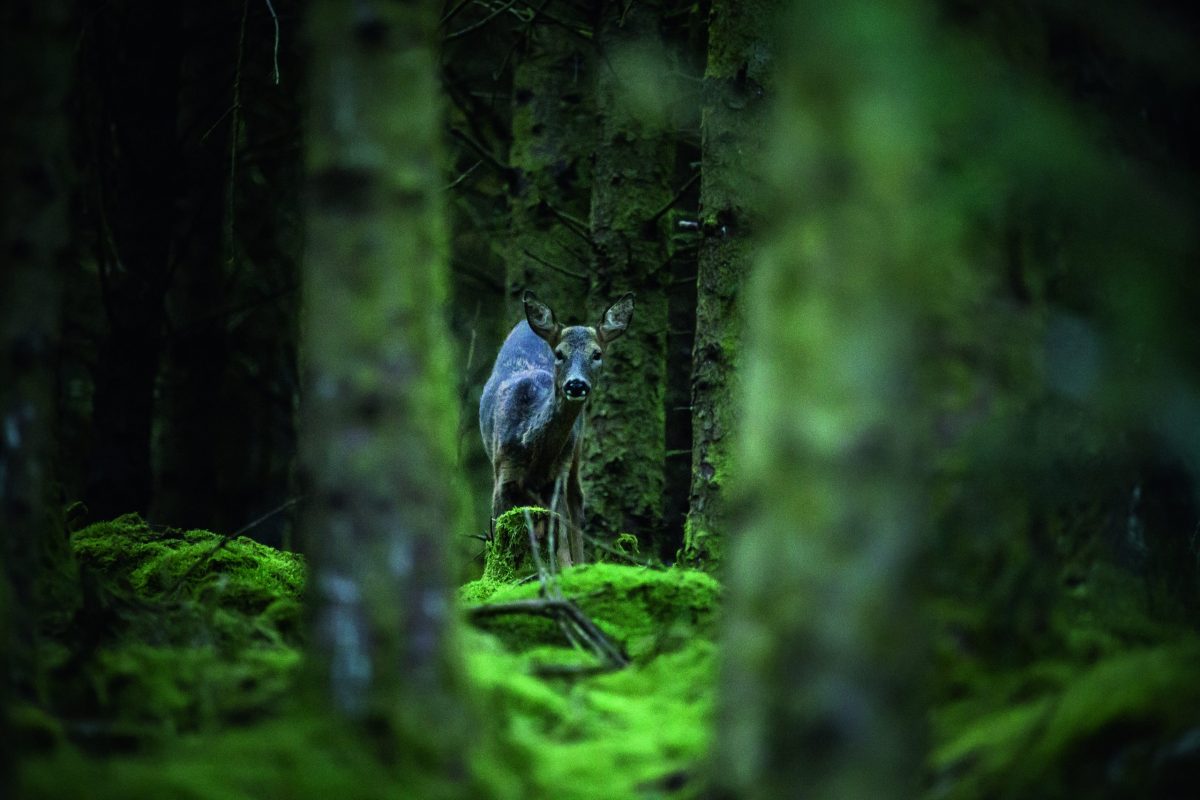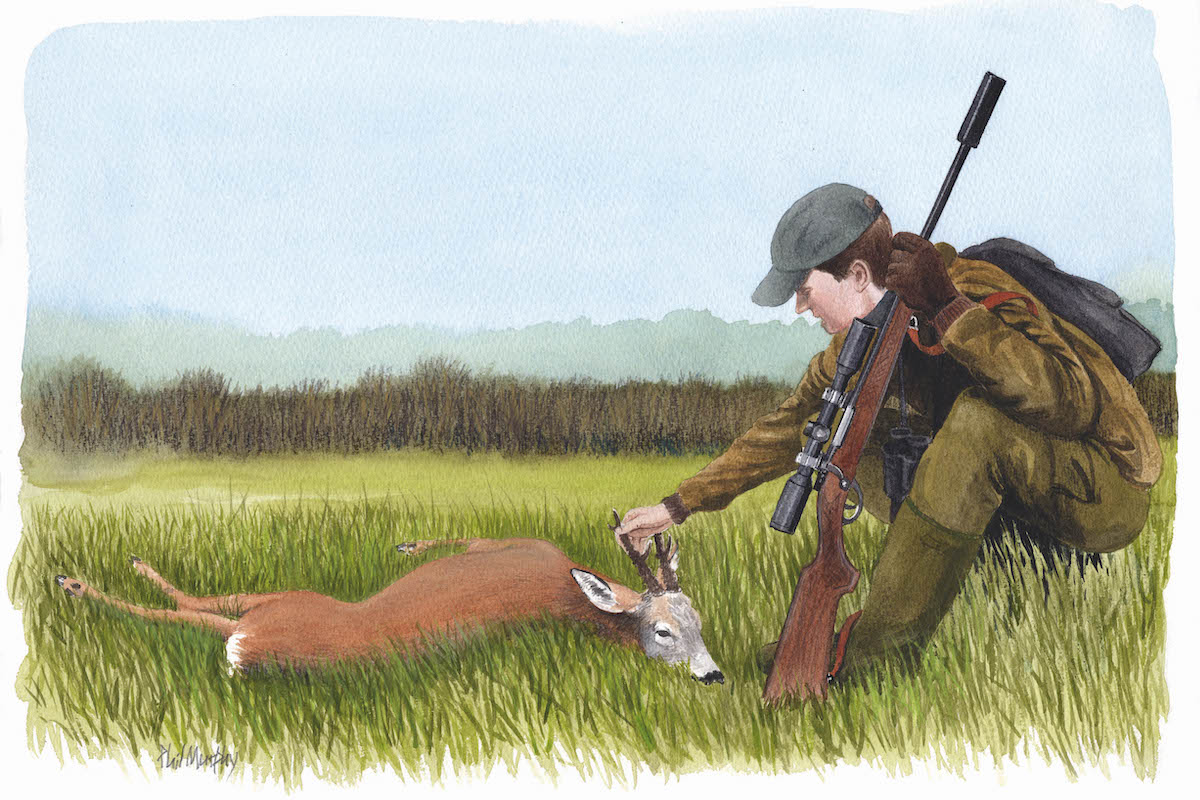Utilising a high seat for deerstalking
Paul Quagliana restocks his freezer after a chance encounter while deerstalking and a bit of detective work

The roe doe slips into view through the thick cover
When it comes to deerstalking, I am very much in the recreational camp. I shot my first roe when I was 18 and since then have probably put a couple in the freezer every year. For several years I have been in a stalking club on a large estate. I class myself as a subsistence hunter who enjoys trying to be self-sufficient, whether that be with guns or rods. If I could afford the luxury of a garden I would grow my own veg.
Stocks
The freezer was running low and the season’s end was approaching, so on an afternoon in early March I headed for one of my favourite spots to see if I could restock my supplies.
The high seat was a double one, which I prefer as I like to have my roe sack in the spare seat next to me with all my bits in. I also wonder whether leaving bags at the bottom of a high seat sends out a scent trail that spooks the deer. Perhaps I am being too fussy though; I have regularly seen stalkers leave their dogs to sit under a high seat regardless of wind direction and it doesn’t seem to bother the deer.
It wasn’t long before a small bunch of fallow emerged but they were a bit far for my abilities, so I watched them going about their business. What was particularly interesting was what may have been a goshawk, I only caught a glimpse, attempting to catch a squirrel that narrowly avoided death by spiralling round the trunk it was clinging to.
Time passed, dusk was approaching, the fallow had faded into the woodland and my feet were getting cold. From the impenetrable undergrowth on my left a roe doe hopped into view. The deer froze, detecting my movement, and I fired. It is well known that if a deer suspects something is amiss will most often run. However, in this case its reaction was unusual. At a range of about 50 yards the report from the rifle may conceal the sound of an impact but normally the deer will leap or jump.
In this instance it simply took off like a scalded cat across the ride and vanished into cover. For a moment I felt like I had fired cotton wool at it and was unsure what had happened. After waiting a few minutes I unloaded the rifle and descended before reloading and going to the spot where the deer had been.
Trace
Following the route I thought it had taken into the thickets I could find no trace of blood. Could I have missed it? A few hours before I had fired a couple of shots to check the zero and it was fine. I hunted around and then sent a message to my keeper friend that to be on the safe side it might be wise to bring his dog. I continued my search and eventually found a few blood spots on the curled, dead oak leaves. That didn’t look very promising, but I took some strong kitchen towel from my pocket and tied it around a branch to mark the spot.
After further search I found more blood, which looked more promising as it was at about the height on some dead brambles to indicate a good chest shot. But still there was very little. Again, I marked the spot with some kitchen towel around a branch as it would make life easier for my friend and his dog to go straight to these rather than hunting for the trail twice.
The trail was intermittent but there were a few more drops and finally I espied the deer through the hazels and brambles, dead as a nit. I am sure fellow stalkers will know the feeling of relief that comes when this happens. I contacted my friend to let him know his dog could stay at home, warm in its bed.
By now it was nearly dark and a powerful headlamp made life a lot easier when it came to gralloching the deer. I shouldered my roe sack, and with a heavy load but a spring in my stride I headed back in the darkness through muddy fields and along a rutted track pockmarked with deep puddles from days of heavy rain. I was looking forward to the culinary delights that would ensue in the weeks to come.
Back at the larder, when skinned, the reason for the meagre blood trail was revealed. The deer had been heart shot and the bullet had entered between the ribs and only really clipped a rib on the way out, leaving little visible damage.
It is a lesson, particularly if you are a novice, not to give up if you think you have missed or the deer does not react how you expect it to. The deer had only gone about 30 yards into cover before dropping but its pelt makes for excellent camouflage and it took some time before I found it.
It is only very occasionally that I have had deer run in these circumstances and this one had curled around to the left, almost 90 degrees, which had thrown me off its trail. I have noticed in a similar situation a deer curling to the left before dropping. Whether this is coincidence or instinct to throw a perceived threat off its trail or whether there is another reason, I don’t know.
Deerstalking tips
- If you are on an estate that has high seats sited by the keeper, know that they are pointing in a certain direction for a reason. Only shoot forwards. Although in some cases it may appear safe, don’t lean round and be tempted to shoot out of the back of a high seat.
- Sharpen your knife when at home and it will always be ready. Try to get a razor edge on it, as it will make life much easier and quicker. It is deemed bad luck by some to sharpen a knife shortly before setting off. Buy a knife with a tough sheath and place it on your belt where it can’t dig into your thigh if you slip or are climbing a high seat ladder.
- Count the cartridges in your bullet pouch before setting off in case you inadvertently drop any when unloading.
- Take a head torch that throws a wide and powerful beam and ensure it is fully charged.
- If a deer is out of range, or out of season, keep watching it. It can be pleasant to simply watch its behaviour but it may also give you some clues. If the deer suddenly looks up and gazes fixedly into woodland, for example, it may have seen another deer approaching, which in turn will prepare you for a possible opportunity.
- Don’t rush, or try to carry too much, when climbing up a high seat; take your time and carry items up in batches.
- Let the keeper know when you have left and report anything interesting you see, as such information could be useful to them.
- Take food, water and warm clothing – the temperature can drop suddenly.
- If using an estate larder to butcher a deer, try to keep it as clean as you can. Keepers are busy people and will not be thrilled to have to clean up after you.
- If the situation allows, the keeper may appreciate you trying to squeak a fox into range. I would normally save that for just before dusk when identifying whether a deer is in season or not can start to become difficult. If you have blanked on the deer you may score some points with the keeper if you manage to bag a fox. But do check with them beforehand if this is acceptable.
Venison recipes
Roe kidneys with Henderson’s Relish

Paul’s roe kidney recipe is delicious served on toast
A friend of mine who hails from Sheffield insisted I try some Henderson’s Relish which, if you are from Sheffield, will hold a special place in your heart. I have to agree that after trying it, it now has a place in mine.
Ingredients
- 2 roe kidneys cut into several pieces
- A good handful of mushrooms, sliced
- Flour
- A big pinch of cayenne pepper
- A big pinch of mustard powder
- Henderson’s Relish
- 250ml beef stock
- A pinch of crushed black pepper
- Chopped parsley to garnish
- Butter for frying
Method
- Flour the kidneys and fry until lightly browned in the butter.
- Add the mushrooms and stir in. Fry for a couple of minutes and then add the cayenne pepper, black pepper and the mustard powder. Stir in.
- Add the beef stock and several large splashes of the Henderson’s Relish and give the whole lot another stir.
- Simmer until the stock has reduced and the kidneys are tender.
Slow cooker venison shoulder

This is a simple but hearty slow cooker recipe
This is really easy and uses very few ingredients. For this dish, I used what I believe is known as the foreshank of a venison shoulder.
Ingredients
- Venison shoulder
- Several potatoes, sliced
- 2 onions, sliced
- Butter
- Beef stock – enough to nearly cover the potatoes and onions
- Gravy granules
- Salt and pepper
Method
- Butter the base of the slow cooker pot and place the potatoes and onions in it.
- Place the venison on top. Add the salt and pepper and then enough beef stock to nearly cover the potatoes and onions.
- Leave for several hours and then test for tenderness. When tender, take some of the stock and use it to make gravy with the gravy granules. It can be served with a range of vegetables and mash.








